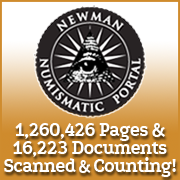
About UsThe Numismatic Bibliomania Society is a non-profit organization devoted to the study and enjoyment of numismatic literature. For more information please see our web site at coinbooks.org SubscriptionsThose wishing to become new E-Sylum subscribers (or wishing to Unsubscribe) can go to the following web page link MembershipThere is a membership application available on the web site Membership Application To join, print the application and return it with your check to the address printed on the application. Print/Digital membership is $40 to addresses in the U.S., and $60 elsewhere. A digital-only membership is available for $25. For those without web access, write to: Terry White, Treasurer AsylumFor Asylum mailing address changes and other membership questions, contact Terry at this email address: terrywhite5475@yahoo.com SubmissionsTo submit items for publication in The E-Sylum, just Reply to this message, or write to the Editor at this address: whomren@gmail.com
BUY THE BOOK BEFORE THE COIN |
- WAYNE'S WORDS: THE E-SYLUM OCTOBER 8, 2017
- NEW BOOK: SECRETS OF SMART COIN-BUYING
- NEW BOOK: U.S. MINT RESTRIKES
- THOMAS BISSELL OLD COINS CATALOGUE NO. 38
- NEWMAN PORTAL SCANS 1902 F. DELOS SALE
- NEWMAN PORTAL SEARCH: “ONE-SIDED PROOF”
- DAVID J. RYDER (RE)NOMINATED AS MINT DIRECTOR
- NOTES FROM E-SYLUM READERS: OCTOBER 8, 2017
- MORE ON EARLY ENGRAVED U.S. MEDALS
- FLOCKS MARCH THROUGH MADRID FOR 25 MARAVEDIS
- WHAT DO WE CALL THOSE DOTS IN LEGENDS?
- VOCABULARY TERM: LEGEND
- FELIX DELOS
- MORE ON MAUNOVRY'S LESHER DOLLAR HOARD
- HARVEY STACK'S NUMISMATIC FAMILY, PART 2
- NOTES ON THE ORIGINS OF THE CONTINENTAL DOLLAR
- SELECTIONS FROM NEWMAN VIII: TALE OF TWO TENS
- TRAVEL QUIZ: QUART AND LI
- NUMISMATIC NUGGETS: OCTOBER 8, 2017
- HARRY'S MEDAL SELECTIONS: OCTOBER 8, 2017
- DECIMUS ALBINUS: THE “OTHER BRUTUS”
- SOUTH BOHEMIA SILVER COIN HOARD DISPLAYED
- NEW COINS FOR QUEEN'S WEDDING ANNIVERSARY
- REPORTER TOURS DE LA RUE BANKNOTE PLANT
- 1928 D. H. LAWRENCE CHEQUE OFFERED
Click here to access the complete archive
To comment or submit articles, reply to whomren@gmail.com
Content presented in The E-Sylum is not necessarily researched or independently fact-checked, and views expressed do not necessarily represent those of the Numismatic Bibliomania Society.
WAYNE'S WORDS: THE E-SYLUM OCTOBER 8, 2017
 New subscribers this week include:
Jake Gomes of New Hampshire, courtesy Tom Caldwell, and
Anthony James, MD.
Welcome aboard! We now have 3,293 subscribers.
New subscribers this week include:
Jake Gomes of New Hampshire, courtesy Tom Caldwell, and
Anthony James, MD.
Welcome aboard! We now have 3,293 subscribers.
Thank you for reading The E-Sylum. If you enjoy it, please send me the email addresses of friends you think may enjoy it as well and I'll send them a subscription with your compliments. Contact me at whomren@gmail.com anytime regarding your subscription, or questions, comments or suggestions about our content.
This week we open with two new books, an old novel with numismatics as a theme, and two notes on the Newman Numismatic Portal. Other topics this week include one-sided proofs, another early reference to Continental Dollars, French-American collector Felix Delos, dealer Maunovry's Lesher Dollar hoard, the "Other Brutus", the Queen's wedding anniversary coin, and De La Rue's banknote factory.
To learn more about the rare coin marketplace, Mickley restrikes, 1804 Dollars, those dots in coin legends, gold coin buying in the Great Depression, the Founding Father of American Numismatics, an 1861 St. Louis Demand Note, the New Yorke in America token, the Minister of Finance, Moneys & Medals, the Slobberer, Lady Chatterley's Lover and a flintlock with a suspiciously warm barrel, read on. Have a great week, everyone!
Wayne Homren
Editor, The E-Sylum
THE BOOK BAZARRE
NEW BOOK: SECRETS OF SMART COIN-BUYING
on the Secrets of Smart Coin-Buying
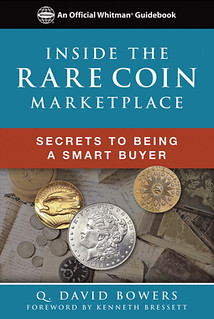 Whitman Publishing announces the release of the newest book by Q. David Bowers. Inside the Rare Coin Marketplace: Secrets to Being a Smart Buyer debuted October 1, 2017. The 320-page full-color volume is available online (including at Whitman.com) and in bookstores and hobby shops nationwide for $14.95.
Whitman Publishing announces the release of the newest book by Q. David Bowers. Inside the Rare Coin Marketplace: Secrets to Being a Smart Buyer debuted October 1, 2017. The 320-page full-color volume is available online (including at Whitman.com) and in bookstores and hobby shops nationwide for $14.95.
Inside the Rare Coin Marketplace shares Bowers’s more than 60 years of experience as a coin collector, professional dealer, award-winning author and researcher, and past president of the American Numismatic Association. He tells how to build a meaningful and significant coin collection on any budget, for your own pleasure, for investment, to share a fun hobby with your friends and family, and to explore history, art, commerce, technology, and many other areas of interest that are touched by coins.
Bowers’s goal, as he writes in his preface: “I would like you to become an expert collector of your choice of specialties: coins, tokens, and/or medals.” His case studies, personal recollections, and advice are accompanied by more than 800 coin and medal photographs, engravings, old cartoons, family photos, and other illustrations.
“I do not pretend to predict cycles for modern art or autographs or restorable Victorian houses,” Bowers writes, “but I have a lifetime of experience with rare coins, enabling me to predict (so far) various sea changes in that market.”
The book’s range is broad, with discussions of the minting process and distribution of coins; planchet quality, sharpness of details, and other eye-appeal factors; cleaning coins; elements of a coin’s value, including but not limited to grade; how to build a great collection; selecting quality and value in the marketplace; modern grading, including third-party certification; a discussion of every type of United States coin; colonial and early American coins and tokens; treasure and shipwreck coins; fair and exposition medals; commemorative coins; pattern coins; Civil War tokens; private and territorial gold coins; good-for tokens; collecting numismatic books; Hard Times tokens; encased postage stamps; Society of Medalist issues and other medals; and counterstamped coins.
Bowers describes coin collecting and market trends dating back to the 1700s—a valuable study that gives insight to modern-day cycles. His final chapter is a “personal scrapbook” of his experiences in the coin market going back to the 1950s. Bowers tells of his start as a coin dealer at the age of 14, meeting and learning from famous coin dealers and collectors like John J. Pittman, Abe Kosoff, and John J. Ford Jr., the changes of the 1960s, numismatic trips to Europe, the U.S. Treasury hoards of silver dollars, developments in the markets, the rise of third-party grading, modern research and publishing, and countless other people, places, and events—all from his personal perspective, and told in his unique style, like sitting down after dinner with an old friend.
Kennth Bressett, longtime editor of the Guide Book of United States Coins (the “Red Book”), wrote the book’s foreword. “Yes, there are secrets to becoming a smart coin buyer and to enjoying a great coin collection,” he says. “Within this book you will learn and benefit from them all.”
Because Whitman Publishing is the Official Supplier of the American Numismatic Association, ANA members receive 10% off when ordering the book directly from the publisher. ANA members can also borrow it for free from the Association’s Dwight N. Manley Numismatic Library.
Inside the Rare Coin Marketplace: Secrets to Being a Smart Buyer
By Q. David Bowers; foreword by Kenneth Bressett
ISBN 0794845258.
Softcover, 6 x 9 inches, 320 pages, full color.
Retail $14.95 U.S.
URL:
https://www.whitman.com/store/Inventory/Detail/Inside-the-Rare-Coin-Market-Secrets-to-Being-a-Smart-Buyer+0794845258

NEW BOOK: U.S. MINT RESTRIKES
I have been working on a book on restrikes since I started writing books many years ago. I have covered restrikes in those books I have written, but wanted to focus just on this subject. Over the past year I started to focus on them.
I spent the last six months just on the Mickley restrikes (1804 Large Cent, 1810 Large Cent, 1823 Large Cent, 1811 Half Cent) I covered the archive records, I was lucky that I spent the last year in Boston and was able to research the Stickney papers, found other cool relevant letters also, have gone through most of the auction catalogues for this period, and collecting any other information relevant. I also read all information that has been printed on the Mickley restrikes. I also documented all die stages for each of these varieties and present clear photos on these with detailed descriptions.
Not sure how long it will take me to complete a book on all restrikes so I figured it would be better to post as I go.
Alan from CoinZip was good enough to let me post it there, its 42 pages, below is the link. Hope you enjoy.
To read the complete draft, see:
http://www.coinzip.com/articlesPage.php?i=59
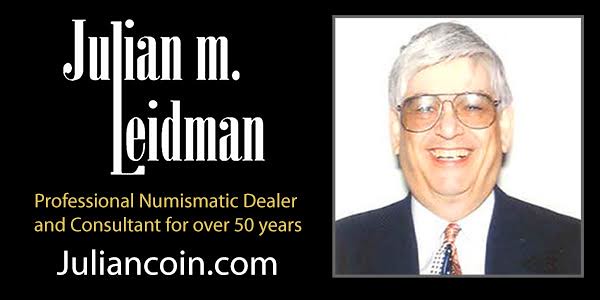
THOMAS BISSELL OLD COINS CATALOGUE NO. 38
Arthur Shippee of Hamden, CT writes:
I came across the following passage in the book The Broken Vase by Rex Stout. It turns out to be a clue. One wonders if this is an accurate reference to a particular catalog.
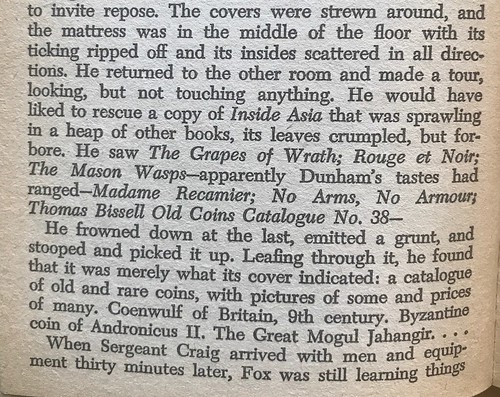
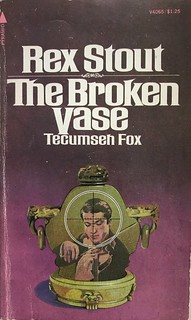
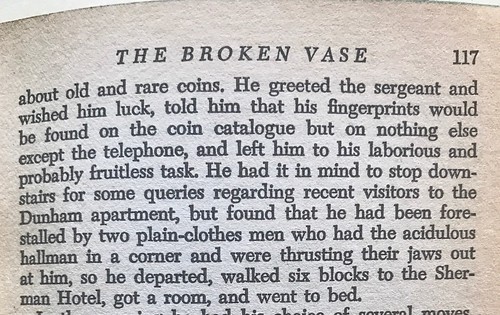
Arthur adds:
It sounds like a good name, doesn't it? I suppose the lawyers would discourage naming an actual source.
The plot point here is that someone had to change hobbies to disguise how he used his funds. And thus his cover begins to unravel.
Tecumseh Fox was one of Rex Stout's secondary leads (of course no one could replace Nero Wolfe and Archie Goodwin). Fox was in ways a mirror Wolfe: he kept a farm in the country, not orchids in the city, and did his own detecting solo.

NEWMAN PORTAL SCANS 1902 F. DELOS SALE
The Lazy Cataloger: A Terse Description of an 1804 Dollar
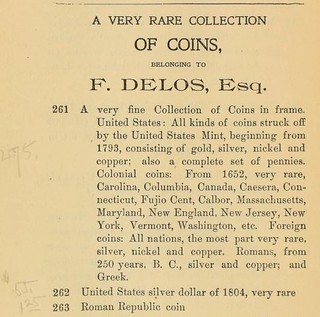 The Fifth Avenue Art Galleries sale of the F. Delos collection (1902) crossed our path this week. The document was scanned at the ANS by Internet Archive associate Lara Jacobs, who has replaced John Graffeo in that position. John was responsible for scanning thousands of U.S. auction catalogs in the ANS library, and we thank him for his contributions. This was the first piece scanned by Lara, and, as almost all sales contain something interesting, we paged through it to see what made this catalog distinctive. At first glance the catalog contains only rare books, none of them numismatic, and we wondered why this catalog was in the ANS library. The answer is revealed on the final page, which suggests that the consignor might not have selected the best auction house to present his collection.
The Fifth Avenue Art Galleries sale of the F. Delos collection (1902) crossed our path this week. The document was scanned at the ANS by Internet Archive associate Lara Jacobs, who has replaced John Graffeo in that position. John was responsible for scanning thousands of U.S. auction catalogs in the ANS library, and we thank him for his contributions. This was the first piece scanned by Lara, and, as almost all sales contain something interesting, we paged through it to see what made this catalog distinctive. At first glance the catalog contains only rare books, none of them numismatic, and we wondered why this catalog was in the ANS library. The answer is revealed on the final page, which suggests that the consignor might not have selected the best auction house to present his collection.
Lot 261 is a group lot of colonial and U.S. type, world, and ancient coins. The cataloger does not state the total number of pieces, but reminds us twice that they are “very rare.” The lot sold for $475, a substantial amount at the time in the numismatic market.
The real prize goes to lot 262, an 1804 dollar, simply cataloged as “United States dollar of 1804, very rare.” Although authenticity was guaranteed by the seller (and not the auction house, another faux pas), the 1804 sold for $55, a shockingly low amount. The Stickney coin sold for $3600 in 1907. The Delos sale took place in New York, and it’s certain the 1804 was a fake, as this coin would not have slipped through in that market.
Link to Delos catalog on Newman Portal:
https://nnp.wustl.edu/library/auctionlots?AucCoId=510744&AuctionId=519282
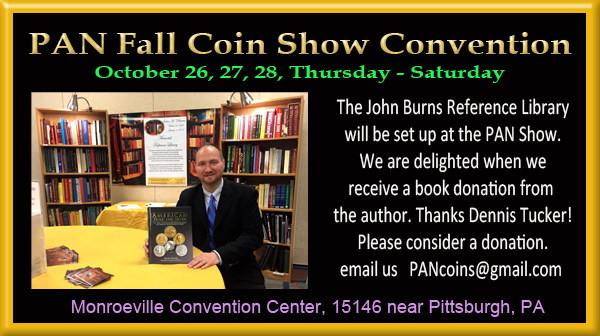
NEWMAN PORTAL SEARCH: “ONE-SIDED PROOF”
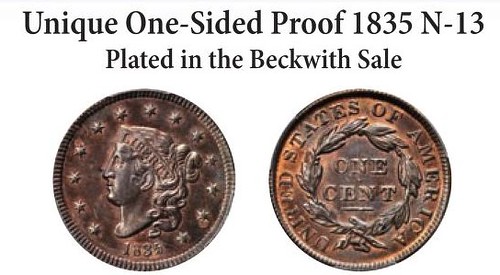
Stack’s Bowers auction sale catalog of the
Twin Leaf collection (July 2015, lot 2262).
The definition of “proof” within the lexicon of American numismatics is surprisingly controversial. Does any sharply struck coin with exceptionally mirrored surfaces qualify as a “proof?” Is the coiner’s intent also required to confer proof status? An anonymous Newman Portal user recently searched on the term “one-sided proof.”
NNP identifies sixty auction lots so described, the earliest being in the 1950s New Netherlands catalogs, and we can thus likely attribute the modern popularization of this term to Walter Breen, who worked for New Netherlands during this period. The term is more frequently associated with large cents of the 1820s and 1830s than with other denominations, and the cataloger of that series, Harold R. Newcomb, wrote of these coins “obverses are perfection, but reverses have the usual mint bloom as found on pieces coined for circulation.”
Stack’s Bowers sales of the Twin Leaf collection (July 2015, lot 2262, an 1835 N-13 large cent) is a typical example. The coin has a storied pedigree including Beckwith, Newcomb, and Naftzger. While PCGS declined to certify the coin as a proof, the catalogers are united on the physical description, with the Goldberg’s attribution being the most succinct: “Proof-60 obverse, MS-62 reverse.” The fact that varied issues in this era are known with proof-like obverses and uncirculated reverses (and not vice versa) certainly suggests intent on the part of the coiner. We look forward to John Dannreuther’s upcoming multi-volume work on United States proof coinage, which will hopefully shed additional light on this question.
Link to NNP auction catalog search for “one-sided proof”:
https://nnp.wustl.edu/library/advancedsearch?
contenttype=Auction&title=&author=&publisher=&searchlow=
&searchhigh=&fullsearchterm=one-sided+proof
Link to Stack’s Bowers Twin Leaf collection, lot 2262:
https://nnp.wustl.edu/library/auctionlots?AucCoId=3&AuctionId=517107&page=141
Link to Harold R. Newcomb’s United States Copper Cents, 1816-1857 on Newman Portal:
https://nnp.wustl.edu/library/book/526320
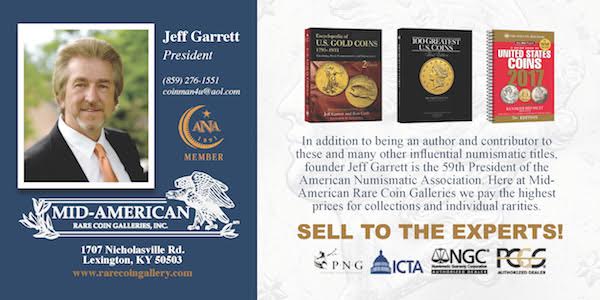
DAVID J. RYDER (RE)NOMINATED AS MINT DIRECTOR
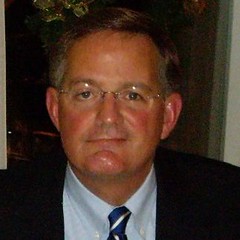 David J. Ryder of New Jersey to be Director of the United States Mint. Mr. Ryder served as manager and managing director of currency for Honeywell Authentication Technologies. Previously, Mr. Ryder served as CEO of Secure Products Corporation, which was acquired by Honeywell in 2007. In 1991, Mr. Ryder was nominated by President George H.W. Bush and confirmed by the U.S. Senate to serve as Director of the U.S. Mint. His prior government service also included Deputy Treasurer of the United States, Assistant to the Vice President and Deputy Chief of Staff to Vice President Daniel Quayle. Mr. Ryder was born in Billings, Montana and raised in Boise, Idaho. A graduate of Boise State University, Mr. Ryder is married with two children.
David J. Ryder of New Jersey to be Director of the United States Mint. Mr. Ryder served as manager and managing director of currency for Honeywell Authentication Technologies. Previously, Mr. Ryder served as CEO of Secure Products Corporation, which was acquired by Honeywell in 2007. In 1991, Mr. Ryder was nominated by President George H.W. Bush and confirmed by the U.S. Senate to serve as Director of the U.S. Mint. His prior government service also included Deputy Treasurer of the United States, Assistant to the Vice President and Deputy Chief of Staff to Vice President Daniel Quayle. Mr. Ryder was born in Billings, Montana and raised in Boise, Idaho. A graduate of Boise State University, Mr. Ryder is married with two children.
Dennis Tucker adds:
Nomination doesn’t always lead to appointment, of course, but it’s a step in that direction. Right now the Mint is headed by Acting Deputy Director David Motl, who was previously its CFO.
Chris Fuccione of Salem, MA writes:
I am glad that Trump appointed a new Mint Director. The last one was Edmund C. Moy who stepped down in 2011 because President Obama did not fill the position during his whole presidency.
I am just questioning his pick. David J. Ryder served as H.W's Mint director from September 1992 to November 1993. That's almost 25 years ago. Would it have been better to pick someone younger with new and fresh ideas than someone who might be out of step with current technologies and the current market?
To read the complete article, see:
President Donald J. Trump Announces Intent to Nominate Personnel to Key Administration Posts
(https://www.whitehouse.gov/the-press-office/2017/10/04/president-donald-j-trump-announces-intent-nominate-personnel-key)
To read Ryder's LinkedIn profile, see:
David J. Ryder
(https://www.linkedin.com/in/david-j-ryder-298a5335/)
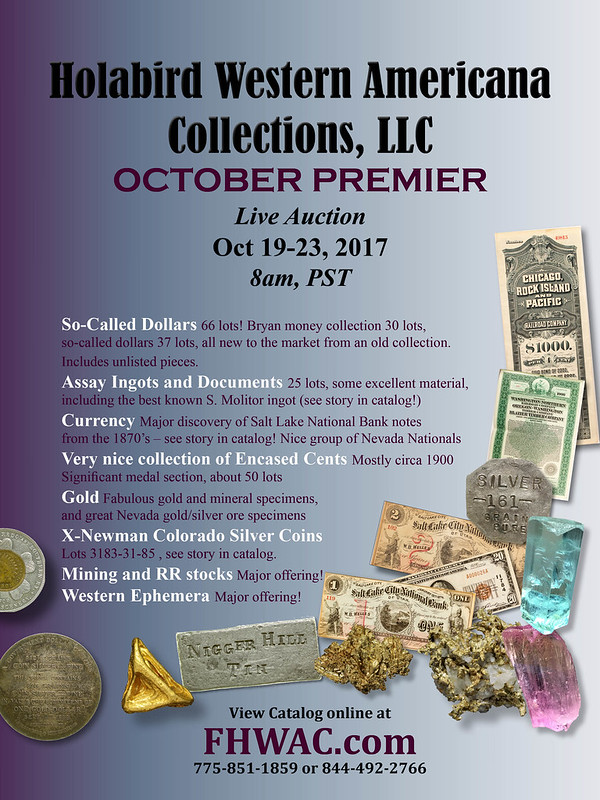
NOTES FROM E-SYLUM READERS: OCTOBER 8, 2017
Spectacular San Francisco Mint Errors
Regarding the two-tailed quarter discussed last week,
Max Hensley writes:
I'm not clear how one can tell the coin was minted in San Francisco. If it was, I can tell you there was monkey business going on at that mint in the 70s. While living in the city I used to go to the Butterfield's auctions of abandoned bank box contents. One lot, around 1995 I recall, was a big bag of the most unbelievable mint errors imaginable - many S mint proofs double struck, off center etc. - all S mint and dated from the same period in the 70s. Clearly someone had been taking things out of the mint and squirreling them away in a bank box, which for obvious reasons was abandoned eventually. I didn't bid on the lot since I thought it would be expensive and invite government inquiry. I don't know whether it sold or what it sold for. But I can tell you that was the most unbelievable hoard of US mint errors ever.
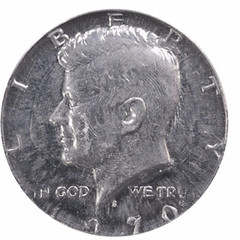 Two Proof error coins that were struck at the San Francisco Mint in the early 1970s and are composed of aluminum were apparently intentionally struck over struck aluminum Shell Coin Game tokens, according to error coin specialist Jon Sullivan of Sullivan Numismatics in Charleston, South Carolina.
Two Proof error coins that were struck at the San Francisco Mint in the early 1970s and are composed of aluminum were apparently intentionally struck over struck aluminum Shell Coin Game tokens, according to error coin specialist Jon Sullivan of Sullivan Numismatics in Charleston, South Carolina.
To read the complete article, see:
Proof Kennedy half dollar, Eisenhower dollar struck over aluminum Shell tokens
(https://www.coinworld.com/news/us-coins/2017/10/1970s-coins-struck-on-aluminum-game-tokens.all.html)
To read earlier E-Sylum articles, see:
TWO-TAILED WASHINGTON QUARTER AUTHENTICATED
(http://www.coinbooks.org/v20/esylum_v20n40a19.html)
MORE ON 1970-S MINT "ERRORS"
(http://www.coinbooks.org/esylum_v19n25a10.html)
U.S. Coins in European Museums
This got lost in my inbox, but after the September 24th issue
Alan V. Weinberg sent this note. He writes:
I distinctly recall touring Europe in 1966 and visiting many museum numismatic collections. The East Berlin museum had a GOLD George Washington Manly original medal on exhibit. The national Copenhagen Museum had a centuries old numismatic collection which included a Gem Unc Noe 1 Oak Tree shilling fully round, a Gem Proof early 1820s quarter, a fully Unc 1795 dollar, etc all of which I held in my hand and had really old pedigrees. That was the summer I discovered the extremely lax security and extensive switching of Sir Joseph Banks Family American rarities like a Gem Unc 1792 half disme donated in 1800 according to its round paper ticket. Still, curiously, they still had two Higley Axes on top of each other and two uncirculated George Clinton cents on top of each other so one can presume the thieves didn't know colonial rarities.
Silver Wedding Anniversary Dollar Tree
 Regarding "25 Silver Dollars for 25 Years of Marriage"
Bern Nagengast writes:
Regarding "25 Silver Dollars for 25 Years of Marriage"
Bern Nagengast writes:
My dad was a retail florist in Albany New York and before the great silver dollar run in the mid-1960's he used to get orders for silver dollar trees to be used as gifts for silver wedding anniversaries. He would get 25 silver dollars from a local bank, mount a driftwood tree on a wooden base, carefully wrap each dollar in a small plastic bag and hang the dollars using green floral wire from the tree branches. He made a number of these silver dollar trees in the early 1960's.
To read the earlier E-Sylum article, see:
NOTES FROM E-SYLUM READERS: OCTOBER 1, 2017 : 25 Silver Dollars for 25 Years of Marriage
(http://www.coinbooks.org/v20/esylum_v20n40a12.html)
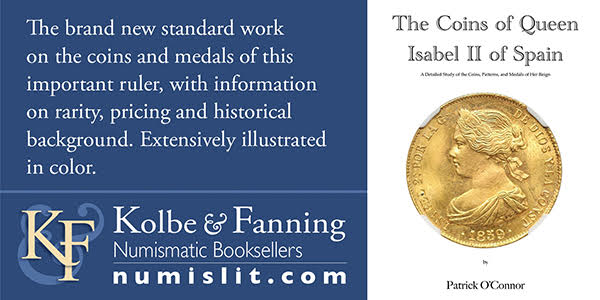
MORE ON EARLY ENGRAVED U.S. MEDALS
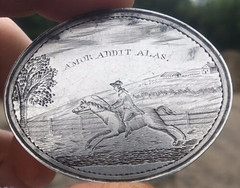

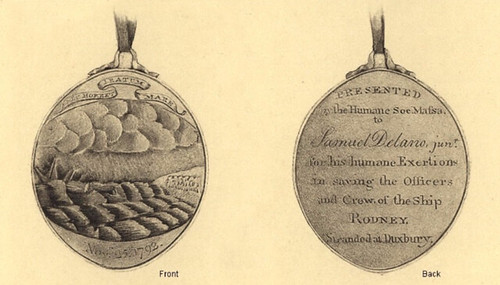

Anne Bentley of the Massachusetts Historical Society writes:
I would suggest the writer visit us to research in the Humane Society of Massachusetts papers, which are on deposit here. We also have all of Revere's smaller engravings to compare with the engraving on the piece. Humane Society records would name this recipient and recount his deed, if they gave him the medal. Also, check in with the research director of the Revere House.
Humane Society of Massachusetts Records (http://www.masshist.org/collection-guides/view/fa0117)
Humane Society of Massachusetts Records (http://www.masshist.org/collection-guides/view/fa0117)
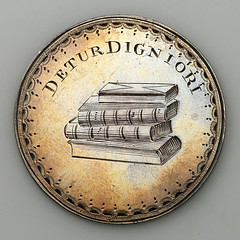
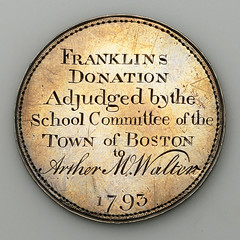
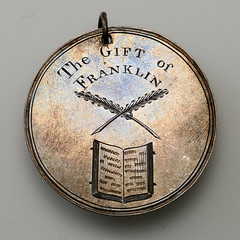

To read the earlier E-Sylum article, see:
QUERY: ENGRAVED JOSIAH LIBBEY LIFESAVING MEDAL
(http://www.coinbooks.org/v20/esylum_v20n40a16.html)
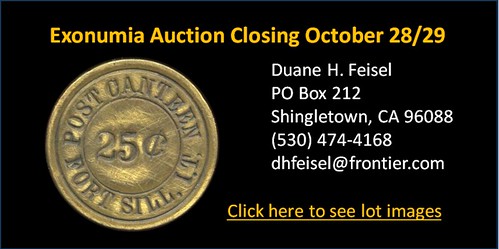
FLOCKS MARCH THROUGH MADRID FOR 25 MARAVEDIS
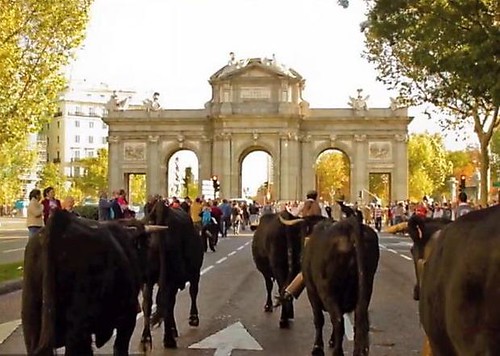
The streets of Madrid saw an entirely different protest on Sunday, as thousands of sheep and other farm animals blocked traffic in the annual "trashumancia", or transhumance event.
The annual transhumance event was held, where more than 2,000 sheep and other farm stock were led through the center of the city to defend ancient grazing, droving and migration rights. This colorful event has been running every year since 1994 and is basically to defend the right to use ancient droving routes, which used to crisscross the fields and woodland, where the sprawling city of Madrid now stands.
These routes have been in existence since around 1273, and the shepherds, following an age-old tradition, have to pay 25 maravedis (a type of coin first minted in the 11th century) to the city hall to use the crossing. Once this is paid, they can then take their flock through the city streets with no hindrance.
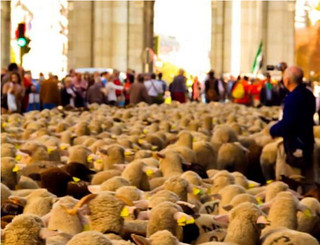 As a tradition, shepherds in Spain have the right to use 78,000 miles (125,000 kilometers) of paths throughout the countryside for seasonal livestock migrations, from the cool mountain pastures in summer, down to the warmer lowland grazing in the winter. This migration is called transhumance, or trashumancia in Spanish, and the Ministry of Agriculture has been promoting the annual fiesta since 1994.
As a tradition, shepherds in Spain have the right to use 78,000 miles (125,000 kilometers) of paths throughout the countryside for seasonal livestock migrations, from the cool mountain pastures in summer, down to the warmer lowland grazing in the winter. This migration is called transhumance, or trashumancia in Spanish, and the Ministry of Agriculture has been promoting the annual fiesta since 1994.
Spaniards are proud of their ancient sheep-rearing traditions. The native Marino breed is highly thought of and has been exported to South America and Australia, where they are renowned in the local wool industries.
To read the complete article, see:
Transhumance — 2,000 sheep stop traffic in Madrid, Spain
(http://www.digitaljournal.com/article/335714)

1) KINGS of SPAIN, Castile. Alfonso VIII. 1158-1214. AV Dobla (Mancus) (26mm, 3.86 gm). Toledo mint. Dated Safar era 1224 (1186 AD). Pseudo-Kufic legend with cross above and ALF below, marginal legend "Struck at Toledo in 1224, Safar era" / Five line legend with star below. C&C 999; Friedberg 101. EF, light coppery toning. The gold coins struck by the early Spanish kings were intended to replace the Almoravid dinars found in wide circulation in the region. The extensive issues of Alfonso VIII of Castile were known as Moribitini or Alfonsini, elsewhere termed the mancus. Alfonso still reigned over a large Muslim population, and the types were acceptable to the merchant classes that dealt with both Muslims and Christians. Although the legends are in Arabic, the sentiments expressed are Christian, and the dates are given not in Christian AD years, but in the local Safar era, beginning in 38 BC.
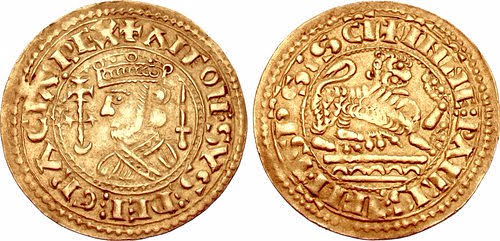
2) SPAIN, Castile & León. Alfonso IX el Baboso (the Slobberer). King of León, 1188-1230. AV Maravedi – Morabetino (27mm, 3.85 g, 6h). Salamanca mint. + ?IFONS : DEI : GR?CI? : REX (triple pellet stops), crowned bust left; before, cross-tipped scepter on crescen, flanked by stars; sword behind / + INNE : P?TRIS : IFLI : ISPS : SCI (triple pellet stops), lion rampant right. ME 1076; Friedberg 47. VF. Extremely rare. Prior to the 12th century, the majority of gold coins circulating in Christian Spain were Islamic in origin. The rulers of Léon did not strike their own gold until the reign of Fernando II, the father of Alfonso. The name of this gold coin was derived from the main source of Islamic gold: the Almoravid (Arabic al-Murabitun) kingdom of North Africa.
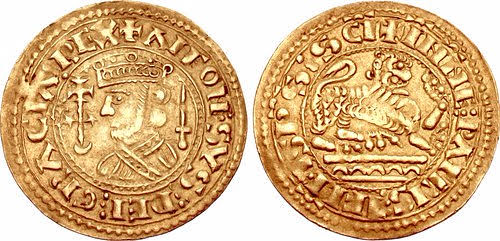
3) SPAIN. Castille and Leon. Pedro I "the Cruel."1350-1369. AV Dobla de 35 Maravedis (4.52 gm). Seville mint. +PETRVS: DEI: GRA: REX: CASTELLE: E LEGI, crowned and cuirassed bust left / +PETRVS: DEI: GRA: REX CASTELE: E LEGI:, arms of Castille and Leon. Cayon y Castan 1267 var. (legend); Burgos 326 var. (same); Heiss pg. 57, 2 var. (same). Good VF, light reverse die break. $2,750.
CNR XXVII, June 2002, lot 126. Pedro I "the Cruel" was invested at age five as the king of Castille and Leon. He married the Bourbon princess Blanca, niece of Charles V of France, and had her killed eight years later at the age of 26. After several other terrible acts he was killed by his brother, Don Enrique.
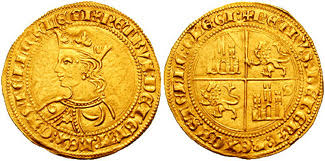
4) SPAIN, Castile & León. Pedro I el Cruel (the Cruel). 1350-1369. BI 4 Maravedís (30mm, 4.36 g, 12h). Sevilla (Seville) mint. Castle façade within polylobe / Lion rampant within polylobe. ME 1297. Near VF.
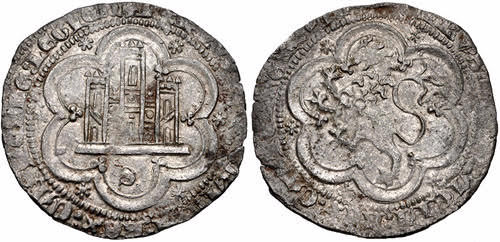
5) SPAIN, Castile & León. Fernando V & Isabel I (Los Reyes Católicos - the Catholic royals). 1474-1504. CU 2 Maravedis (26mm, 4.36 g, 12h). Cuenca mint. Three-towered castle façade; patriarchal cross and C flanking; pomegranate in exergue / Crowned lion passant left. Cf. ME 24579; cf. MEC 6, 846 (both refs for type). VF, dark brown patina, hint of weak strike at center.
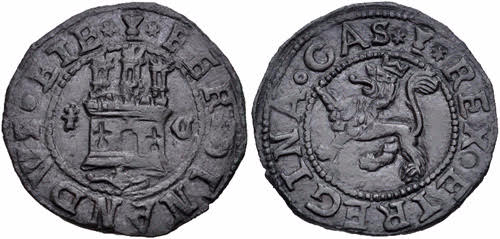
6) SPAIN, Reino de España. Felipe IV el Grande. 1621-1665. Æ 8 Maravedis (27mm, 5.54 g, 12h). Segovia mint. Dated 1623. Crowned arms of Castile / Crowned arms of Leon. ME 5413; KM 10.6. EF, brown surfaces.
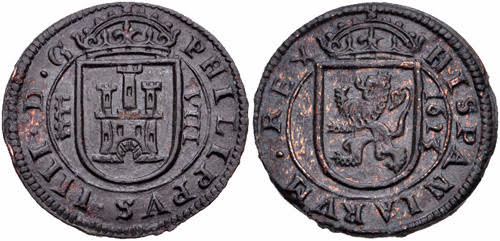
7) SPAIN, Reino de España. Carlos III. 1759-1788. Æ Maravedí (15mm, 1.48 g, 12h). Segovia mint. Dated 1772. Garlanded head right / Coat-of-arms within wreath. ME 10930; Calicó 1926; KM 405.2. Choice EF, red-brown surfaces.
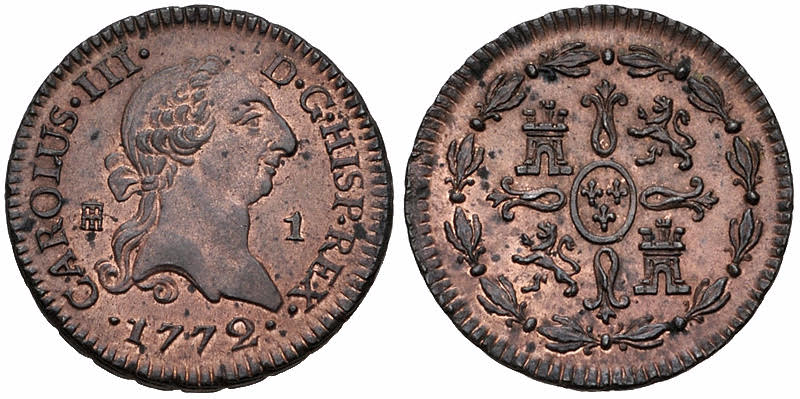
8) SPAIN, Reino de España. Isabel II. 1833-1868. CU 4 Maravedi (24mm, 5.14 g, 12h). Jubia mint. 1847 JA. ME 16646; KM 530.2. UNC, red and brown surfaces, minor spotting. From the HLT Collection.
To visit the CNG web site see:
https://cngcoins.com/
The strange annual transhumance occurrence in Spain is referred to as the cañada ("passage") of the livestock whose proprietors, originally small-holders but later principally nobles and the church, were called the Mesta ("Mixed") meaning free-ranging animals (sheep), whose right-of-way, by the hundreds of thousands, landowners (read poor farmers!) were forbidden to block. The favoritism given to this element of society contributed mightily to the backwardness and economic devastation of Spain in the late Middle Ages and early modern period -- part of the anti-progressive elements that contributed to the Spanish Empire's downfall.
One of my old professors waxed on about this phenomenon, and I have always remembered and marveled over it! I didn't realize, though, that it is still going on in at least some small way (it was supposedly "abolished" in the 1830s, I have read). I guess we can think of this as the first cattlemen's association (cattle in the form of its origin, as "chattel"), and as the practice that eventually gave rise to the famous cattle drives of the American West.

WHAT DO WE CALL THOSE DOTS IN LEGENDS?
Nicholas Graver inquired this week asking a question that sent me on a delightful research journey. I found the answer, a term I did not have in my Encyclopedia of Coin and Medal Technology. So I will have to add it to the next revision. Here’s what Nick said:
Most of my early George Eastman Long Service medals have “dots” between words in the inscription.
So*the*words*are*separated*like*this. But not all have the ‘dots.’
What is the proper term for such dots? Is there a convention [custom] that dictates when such ornaments are used? I suspect it goes way back in history to Roman inscriptions on ancient buildings? I will be corresponding and later publishing an article and need to mention them correctly.
The most common use in numismatics is center dot. Technically it is interpunct, meaning interword separation. But it also called centered dot, interpoint, middle dot and middot, according to Wikipedia.
Nick is correct in that it does originate with Latin inscriptions on buildings. These were all in capital letters with the center dot punctuation mark between words. The same custom exists for legends, the lettering on coins and medals adjacent to the item’s edge. When these became heavily abbreviated, particularly for titles of royalty the center dots became mandatory to separate the abbreviated titles.
In Latin American and some European countries the center dot on their coins became more elaborately designed. Center dots were replaced by rosettes, stars, four leafs and such. These were similar to a class of type used by printers, known by colorful names as dingbats and doodads . The punches which made these ornamental center marks, were made, in fact, by the same type houses which supplied printer’s type.
More recently the center dots are still found on modern coins and medals for artistic effect. In cataloging and describing mention should be made of center dots and their shape. Many computer type faces have these same designs in their symbols section.
The short answer for Nick is to call them center dots.
Center Dots
When a die-sinker wanted to add legends to a die, he would often use a compass to create so-called scribe lines. One point of the compass was pressed into the center of the coin—often
making an indentation in the die—while the other point was used to inscribe two circles of different
diameters. These circles, or scribe lines, were then used as guides for the placement of
the legends. The center dot and occasionally the scribe lines from the dies were sometimes
struck onto the finished coins...
To read the complete Wikipedia article, see:
Interpunct
(https://en.wikipedia.org/wiki/Interpunct)
To read the Colonial Newsletter article, see:
https://nnp.wustl.edu/library/book/514012?page=44
VOCABULARY TERM: LEGEND
Legend.
The lettering following the contour, circumference or outer shape of a coin or medal; the wording near the edge, most often in a form of an arc just inside the border. Lettering in such an arc is called BOWED (the letters have a bowed base line). The legend differs from INSCRIPTION (virtually all other lettering on a numismatic or medallic piece, on a straight base line, most often horizontal); it also differs from the EXERGUE (lettering in the area below a line across the bottom of the device). Legends on coins and medals reinforce the theme and concept of their design and occasionally are like the wider meaning of the word legend: repeating a statement from a previous generation. In England legends are called
The wording in a legend is often contracted or abbreviated to get the required statement into a small space. Also legends are often in a language different from the country issued – as Latin – to further add to their obscurity. Translating legends, however, is a vital function of numismatic study and legends are often indexed in numismatic literature.
Legends are always in capital letters. Occasionally the words in a legend are separated by a CENTER DOT. This is at the option of the item’s designer, there are no rules regarding these. In modern times the use of center dots is for artistic effect. When cataloging, including the center dots is part of a legend’s description.
A legend containing errors of any kind (misspelled words or titles, errors of dates or figures, or mis-struck letters) is called BLUNDERED LEGEND. Legends normally run clockwise, or left to right, however Arabic and other languages read right to left. Legend is also the lettering on a coat of arms or heraldic shield in any position. The legend may also be a motto, somewhat of a slogan, if it appears next to the border.
Multiple line legends. The legend is usually only one row of lettering along the rim, adjacent to the border or border elements. However, the legend may be more than one line. Such a DOUBLE LEGEND was used as early as 1250 on French coins.
Three or more lines of legend are rare, but do exist. An extreme case is a six-line MULTIPLE LEGEND on the Barcelona Columns of Julia Augusta Medal of 1970, issued by Calico in Spain. The legend has a list of countries throughout the world with cities named Barcelona. A spiral legend is a circular legend that runs in an ever decreasing pathway inside previous lettering, a VOLUTE, often to the very center of the design.
Early legend technique. Hill and Pollard in Medals of the Renaissance tell of early portrait medals modeled on a disk and the legend modeled on a separate ring that fits closely around the disk. Examples are found with the lettering in different positions in relation to the portrait, so the ring was kept separate, and rotated to different positions between castings. This method was employed in the 15th century by Amadeo da Milano, a jeweler turned medallist, by Enzola and others. See BORDER.
References: CLASS 02.10
Looking for the meaning of a numismatic word, or the description of a term? Try the Newman Numismatic Portal's Numismatic Dictionary at:
https://nnp.wustl.edu/library/dictionary
Felix Delos, was born on March 28, 1859 in Toulouse, France. He first came to America on July 29, 1879. His final journey to America was aboard the ship La Bougogne on June 30, 1890 sailing from Le Havre, France, together with his friend a fellow sculptor Alexandre Hedouin.
In the 1892 New York City Directory on page 330 he is listed as an upholsterer living at 360 West 49th Street. He married Marie M. Lormand, also a French native, on January 26, 1896, Brooklyn, Kings, New York. He was a French-American numismatist, 501 West Fifty-Second Street, NY, a professional sculptor and marble cutter by trade. On October 8, 1895, he became a naturalized citizen of the United States.
Delos read in the New York Sun newspaper about the discovery of an 1804 Dollar in Montana in change by Billy Seymour, a bartender. Learning the 1804 Dollar was valued in the thousands of dollars he wrote to the editor of The Sun to report that he also owned an 1804 Dollar. According to The Numismatist several experts examined the 1804 Dollar owned by Delos and they pronounced it genuine. The most prominent numismatists available to check out the coin at that time who most probably were contacted by The Sun were Lyman Haynes Low, David Proskey, and Henry Chapman, Jr.
Apparently Delos sold his collection in haste to raise funds to take a trip back to Toulouse, France for family and business. In haste there was no advertisement of his coin collection being sold at auction resulting in very poor prices realized. He lost $45 on the 1804 Dollar! Incredible!
On August 23, 1902 he and his wife Marie sailed on S. S. La Savoie from Le Havre, France to New York.
Nothing more is known of him beyond the 1905 New York Census report.
To read the complete article, see:
The entire inventory of the Lupia Numismatic Library is for sale.
Since neither the Chapman Family Correspondence Archive as a whole nor that of Hiram Edmond Deats could find an institutional or private buyer they shall, unfortunately, be broken up into parcels and sold from the
NumismaticMall.com.
Every item in the Deats and Chapman Archives will be sold to anyone bidding a fair market price. Individual items will be available before the remaining archives are broken up into parcels sold at philatelic auctions in the U. S. and Hong Kong.
Check
NumismaticMall.com frequently as dozens of new items with estimates will be posted daily beginning August 21, 2017 until everything is sold lock stock and barrel. Many treasures and surprises will be found, so keep looking.
All inquiries will be given prompt and courteous attention. Write to:
john@numismaticmall.com
.
I studied Jean Fabien Maunovry in connection with the research for Forgotten Colorado Silver and can add a little more to this account. Mrs. Maunovry died in Denver on March 30, 1979 at the age of 101, according to the Goulder/Kurt Family Tree in Ancestry.com. Her ashes are apparently buried in Fairmount Cemetery, Denver, next to her first husband, Clark C. Fenner.
This family tree seems to be the only authority for Maunovry's September 21, 1921 disappearance; I stayed in Colorado Springs for a few days after the Golden Day at the American Numismatic Association headquarters this past August, and visited the Penrose Library there. The local history department has no file on Maunovry, and he does not appear in the periodicals index either (also checked "coin dealer"), so his "disappearance" was not reported at the time and must come from family tradition. (I was unsuccessful in contacting the originator of the family tree to determine their source.)
Maunovry is listed in the 1922 Colorado Springs city directory, surveyed Jan. 1-April 15, 1922, but this may be an oversight. In 1924 he was still listed as a member of the Rochester Numismatic Society, Rochester, NY, but with no address.
Lupia stated:
"He [Maunovry] claims he purchased a hoard of Lesher silver dollars while living in Denver in 1905 as reported in 1918 by Farran Zerbe."
I would argue that the evidence is not strong enough to state that the hoard was actually purchased in Denver; I would also dispute use of the word "claims," which to me implies the writer believes the statement has no foundation in fact.
Here's what Zerbe actually wrote:
"The quantity accumulator is Jean Maunovry, now of Rochester, New York, who was for some years a resident of Denver and interested in mining claims in the Cripple Creek district. Mr. Maunovry says he purchased from one person a lot of about one hundred in 1905, and several at different times from banks, curio shops and individuals."
Zerbe did NOT write that this lot was purchased in Denver.
From studying Farran Zerbe's correspondence on Lesher Dollars at the American Numismatic Society archives, I became impressed with his careful, cautious approach to Lesher Dollar research. He was also in 1918 one of the most aggressive Lesher collectors, and had no incentive to make them appear commoner than they were. Clearly he was satisfied that Maunovry's holdings were what Maunovry said they were.
Based on Zerbe's actual statement, I would offer this summary of the transaction, restating Maunovry's "claim" as Zerbe's "report."
Farran Zerbe reported in 1918 that Maunovry
purchased a hoard of about 100 Lesher silver dollars in 1905.
For Mrs. Maunovry's entry on Find A Grave, see:
Clark C Fenner
(https://www.findagrave.com/cgi-bin/fg.cgi?page=pv&GRid=34118604&PIpi=15723436)
To read the earlier E-Sylum articles, see:
As a child, on the days I was free from public elementary school, mostly Saturdays and holidays, my father would take me to the store to do many chores. These included wiping the counters, cleaning the front windows, sweeping the floors, and other physical work. But, I often was allowed to open rolls of coins and sort them to be added to our stock. Other times I even greeted visitors if my dad and uncle were busy with others.
I should mention that at this time Stack's, and most other dealers in New York and around the country, also had a Postage Stamp Department. Ours was not necessarily large, but many clients collected both coins and stamps and we wanted to be of service in any way we could. However, after a group of rarer stamps went missing on a Saturday near the end of the Depression, Stack's gave up the postage stamp business. They sold off all their stamps in short order and specialized solely in numismatics.
Coin dealers also bought and sold gold. Some dealers even bought gold objects like jewelry, eyeglass frames and gold teeth. At this time, after the Gold Acts of 1933-1934 mandated that gold coins had to be surrendered to the government, many turned to coin dealers to receive a premium price that they couldn't get from banks. Because gold collector coins were exempt, it was legal to own them so coin dealers could buy and sell gold coins to collectors as well as to the general public.
The buying and selling of gold coins helped dealers stay in business; it offered them a chance to make a few dollars on each purchase, and provide a place for sellers to sell their gold. It was the period of the Great Depression. The Stock Market had crashed, millions were out of work and had lost their savings and homes, and poverty was growing. People sold whatever valuables they could to survive. So coin dealers provided a means for many to sell, and at the same time provided a means for those who collected to add to their collections.
Not everyone was wiped out by the Depression. Some people, like Col. E.H.R. Green, were able to buy large quantities of gold coins during this period. Col. Green was able to assemble a massive collection of gold, including many duplicates. He loved owning the gold coins of the United States and specialized in the early issues from 1795 through 1861. Later, when parts of Green's collection were sold by Chase National Bank (his executors), hundreds of early issues of U.S. gold were able to re-enter the market. If Col. Green and others had lacked the resources to buy much of the gold that became available during the Depression, it is likely that many items that are considered scarcities would be great rarities today, and some of today's rarities would be impossible to find.
Stack's was fortunate to have had funds available to continue business, even in the Depression. Because of this, collectors and the public came to Stack's to sell their coins, gold, silver and copper from the United States and around the world. So we added to our inventory, sold most that we had on hand, and were able to help build some incredible collections, many of which we were later honored to sell.
In my next article I will tell of an exciting experience I had with Col. E.H.R. Green when I was just a youngster.
To read the complete article, see:
To read the earlier E-Sylum article, see:
Bill Nyberg writes:
In his book The Eagle That Is Forgotten: Pierre Eugene Du Simitiere, Founding Father of American Numismatics, author Dr. Joel Orosz quotes Du Simitiere, “a Coin…with devices and mottos taken from the continental paper money, Struckt in London on Type-Metal, and dated 1776.” The quote dates from sometime between 1783 to his death in October of 1784. Du Simitiere’s statement carries considerable weight, as he was deeply involved in artistic circles of America, and was a collector, researcher, and author of American numismatics.
Wherever the 1776 dated Continental pieces were made, a substantial investment in capital and labor was required long before they were struck, including the design, fabrication, assembly, and set-up of a large screw press, rolling machinery, and a complex edge marking and upsetting machine.
In his diary, Robert Morris describes a lengthy and difficult time to obtain “screws and rollers” for the 1783 United States pattern coins. The 1794 dollars were weakly struck because the large screw press would not be completed until months later. Also, the December 15, 1797 Act of Congress lengthened the effective date by six months for federal revenue stamps, because of the extensive time needed for Adam Eckfeldt to fabricate screw presses for the revenue stamps.
All of this evidence indicates considerable time, cost, and technical skills were needed for the large Continental pieces. Could this have been done in America in 1776?
It would be very beneficial to conduct a comprehensive edge die study on the Continental Dollars. The edge die designs could possibly provide positive links to contemporary medals, tokens, or coins in Great Britain or other countries.
Bill Eckberg writes:
Eric Newman, 1952. "The 1776 Continental Currency Coinage". Coin Collector’s Journal. 19 #4. The description of this article in the back of Truth Seeker is accurate. It says the coins exist (they do), “but the journals of the Continental Congress are silent as to official authorization for such coinage. Newman provides indirect [my italics] evidence that the Continental Congress planned for a $1 coin to replace the $1 paper currency note in about July 1776." Whichever of the authors did the annotated bibliography, unlike many catalogers over the past 65 years, was very careful not to overstate what Eric wrote.
Eric Newman and Maureen Levine. 2014. "18th century writings on the Continental Currency dollar coin". Numismatist 127, 34-57. This article pushes the first recorded appearance of the coins (with the inscriptions in German!) to late 1783 in an article that also illustrated the Libertas Americana medal. They also report a vague satirical reference to “pewter dollars” from 1779, but what this refers to, if anything at all, is unknown.
Bill Eckberg adds:
On the more general topic of numismatic research and writing, Bill Eckberg offers this:
I wanted to mention one of my favorite terms from Harry Salyards. He calls it “History Past Subjunctive.”
E.g., “certainly they would have done,” “Surely he would have thought,” etc.
Unfortunately, there is a lot of this in numismatic writing. One of the reasons I loved the 1792: Birth of a Nation's Coinage book so much is that there is none of that crap in it. They speculate occasionally, but when they do, they say that’s what they’re doing.
How much weight should we attach to Du Simitiere's (DS for short) statement that Continental Dollars were struck in London? DS was a voracious collector of both objects and information. Many Revolutionary-era pamphlets exist today only because he collected and saved a copy.
DS also was a citizen of the world. As a Swiss national, he was neither a patriot nor a loyalist. As a man who was barely scraping by in the colonies, he couldn't afford ideogical purity; he would work with anyone who paid him, or had objects to donate to his museum. So could he have done business with a Briton who had first-hand knowledge of
where Continental Dollars were struck? Absolutely!
There is a record of DS doing numismatic business with a British officer, Major Thomas James of the Second Batallion of the Royal Artillery. in fact, as of 1768, the Major commanded all of His Majesty's artillery in Britain's North American provinces. (Kudos to Erik Goldstein, curator at Colonial Williamsburg, for identifying the Major's full name and duty posting, for he is only "Major James" in DS's records). Clearly, DS was glad to "talk coins" with British collectors.
Therefore, the DS statement about Continental Dollars that Bill Nyberg rediscovered must be taken seriously as evidence in this matter, for it could represent informed contemporary knowledge that DS transcribed.
It should not, however, be regarded as definitive. DS recorded a great deal of information he gleaned from sources whose reliability was all over the landscape. This could also have represented contemporary groundless speculation that DS recorded.
We know more about the subject today, but when it comes to the big questions of when and where the Continental Dollars were struck, we are right back to where Eric Newman was in 1952 when he wrote "The 1776 Continental Currency Coinage" for the Coin Collector's Journal. To answer Bill Eckberg's question, I was the co-author who wrote Truth Seeker's annotated bibliography of Eric's publications, and I was careful to respect Eric's precise handling of the evidence.
Neither Eric--nor anyone else, as of yet--has found unequivocal evidence that would settle these questions. So we are left with coins that could have been struck in England or in the new United States, in 1776 or slightly later.
It's one of the biggest unsolved mysteries of American numismatics, and my prediction is that before I shuffle off this mortal coil, some intrepid researcher will find the definitive answer.
Bill Eckberg adds:
Somewhere, there must be a record of them being made. Someone had to pay for them; someone had to have made them. I think we can exclude the U.S. Congress, as there is no record that they paid for such things, and they did not regulate them in 1792 when they regulated the value of every other coinage in circulation.
To read the earlier E-Sylum articles, see:
Selections from the Eric P. Newman Collection VIII, to be
sold November 1-2 in Dallas, features over 1,200 lots of
significant American paper currency from all genres.
Cataloged in two volumes, this sale is the eighth in the
ongoing Signature series. Bound in the first volume are
Colonial, Continental, Obsolete, Confederate, Federal, and
National notes. The second volume is dedicated to Eric’s
Missouri currency collection. ranging from the handwritten
pre-banking “Bon Scrip” payable in pelts or skins to 20 th
century Depression-era scrip. Collected across nine
decades, most of these notes have never appeared at
auction. Part VIII is sold in conjunction with Part IX, which
presents Colonial and United States coins highlighted by
the finest privately held Original Confederate States of
America Half-Dollar.
In this currency sale, two items stand out historically
and are certain to garner strong attention from
numismatists. This “Tale of Two Tens” revolves around a
pair of exceptionally interesting $10 notes from different
genres and circumstances, but both deeply woven into the
fabric of Missouri currency.
The Bank of St. Louis $10
The Bank of St. Louis $10 type engraved by Leney &
Rollinson in 1817 features the titled vignette, “Partial View
of St. Louis,” created for the series and bank. In his first
published numismatic article for the Missouri Historical
Society in 1941, Eric identifies the buildings and landmarks
portrayed in the vignette. The article (reproduced in
Volume 2 of the catalog) discusses in a compact seven-
page narrative the genesis of the Missouri Territorial banks
evolving from the handwritten “bon scrip” backed by
warehouse-stored skins. The sale includes a high-grade,
fully issued note of the type as well as the unique proof
originally from the Leney & Rollinson archive proof book.
To read the complete lot description, see:
1861 St. Louis Demand Note
Our second “Tale Telling Ten” is a legendary Federal
Currency rarity offered at public auction for the first time.
The Newman Fr. 10 1861 St. Louis Demand Note is the
finest by far of the four known. Demand Notes were the
first circulating “greenbacks” to fund the Civil War and
were initially payable in gold until the specie suspension in
late 1861. Only 48,000 St. Louis $10 Demand Notes were
printed, far less than the three eastern offices, making it
rare from the start.
This documented transaction (two letters are included in
Volume 1 of the catalog) was concluded at the same time
Eric significantly augmented his Missouri Obsolete
currency collection with the acquisition of Wismer’s
unique color proofs and other rarities. This is one of the
rarest Federal currency types and is in superb condition.
To read the complete lot description, see:
The Selections from the Eric P. Newman Part VIII
sale promises to be a historic numismatic event. Cataloged
within the two volumes are notes in all price ranges and
interest areas from the 18th to 20th centuries. Catalogs will
be available from Heritage Auctions approximately mid-
October, and all lots are currently in preview at HA.com.
2017 November 1 - 2 Eric P. Newman VIII Currency Signature Auction - Dallas #3547
(https://currency.ha.com/c/auction-home.zx?saleNo=3547&ic=hero-NewmanVIII-AuctionHome-auction3547-091815)
Regarding our recent TRAVEL QUIZ,
Martin Purdy writes:
Quart was a denomination used in the British territory of Gibraltar, based on the Spanish Cuarto as I understand it (examples can be found with a quick Google image search).
Li was a denomination in the Japanese puppet state of Manchukuo in the 1930s-40s (1/10 fen, equivalent to the Japanese "rin" or 1/10 sen - the same base Chinese character, even if the values weren't quite the same, anyway).
With a cue from Martin’s comments, I was able to find the following, edited from Wikipedia. He is right on both denominations. Many thanks, Martin!
QUART In 1741, [in Gibraltar] the following rates of exchange were established: 2 blancas = 1 maravedi, 4 maravedíes = 1 quarto or quart, 16 quartos = 1 real de vellón, 8 reales de vellón = 1 peso sencillo ("current" dollar), 10 reales de vellón = 1 peso fuerte ("hard" dollar, also known as the Spanish dollar). [ . . . ] Much of the currency in circulation was in the form of copper coins, since the low value of silver coins relative to billon lead [ sic ] to most silver being exported from Gibraltar to Spain. Copper merchants' tokens denominated in quarts were issued between 1802 and 1820.
LI Due to worldwide fluctuations in the price of silver during the 1930s, Manchukuo took the yuan off the silver standard in 1935 and subsequently pegged the yuan to, and later reached approximate exchange parity with, the Japanese yen. [ . . . ] Throughout this period about half the value of the issued notes was backed by specie reserves. The notes issued were in five denominations, one hundred, ten, five and one yuan and five chiao (one-half yuan) [. . . ] The Yuan was subdivided into 10 chiao (?), 100 fen (?) or 1000 li (?). Coins were issued in denominations of 5 li up to 10 fen.
To read the earlier E-Sylum article, see:
Washington Success Token
Description: "SUCCESS MEDAL" UNDATED FROM MID 19th CENTURY, SMALL, XF
To read the complete lot description, see:
To read some articles on the Newman Portal, see:
New Yorke in America Token
Finest known Yorke in America token. The conventional wisdom on this 17th Century token was that they were manufactured for the English Governor of New York, Francis Lovelace, who served from 1668-1673. This incredibly well preserved example has no wear and excellent color... Listed on page 49 of the Redbook.
To read the complete item description, see:
For more information, see the Notre Dame entry:
1795 Cohen-2a Half Cent
Also featured is an exceptional early half cent, traceable back over half a century to Stack's offering of the Joseph L. Brobston Collection of U.S. Half Cents in January 1963. Struck in 1795 from the Cohen-2a dies, this coin's appeal is obvious upon first glance, with rich mahogany-bronze patina and steel blue accents atop the highest points. The luster is fully intact and satiny, flooding the fields. In his 1983 Encyclopedia on the denomination, Walter Breen suggests that this specimen might be the same as the John Mills-David Wilson example ranked seventh in his census, though an examination of the plates on the Newman Numismatic Portal has dispelled this notion. Even so, the present example sits in the mid-range of the condition census, approaching Mint State quality in many respects.
Nicely centered on each side, the denticles are full and the focal elements are sharply defined, especially on the reverse. The eponymous "punctuation" between the first two digits of the date is bold and accompanies similar scattered die chips and cracks in the peripheries. Early American copper specialists will be sure to recognize the significance of the present offering!
This handsome rarity from the early days of the U.S. Mint will be offered in lot 1005 of our November 2017 Official Auction of the Whitman Coin & Collectibles Baltimore Expo
To read the complete article, see:
1946 Arko-Lewis Associates Encased Cent
To read the complete lot description, see:
1904 Vienna Numismatic Society Tour Medal
We are offering a very beautiful medal from Austria, the 1904 Austrian Silver Medal Issued for Vienna Numismatic Society Tour of Pressburg. The medal is 29.41 mm x 42.1 mm and is made of silver (I had it tested and it came back 94% silver content) (with a total weight of .685 ounces or 19.4 grams). The medal has very beautiful toned silver color, and sharp well detailed and very, very high relief surfaces.
Harry writes:
This plaquette begs the question: What was in Pressburg in 1904 that the Vienna Club would go see it and then strike a medal memorializing it?
To read the complete lot description, see:
1889 Minister of Finance, Moneys & Medals Medal
Up for bid is a medal from France that commemorates the 1889 centennial of the Minister of Finances Administration of Monies and Medals! A liberty type of figure instructing a youth on the front and operating a coin minting machine with "Unite, Precision, Regularite, 1789-1889 on one side and a landscape of Paris, including the Eiffel Tower with "Ministere Des Finances Administration des Monnaies et Medalles, "Centenaire de 1789" on the other side. Bronze composition, about 51 mm in diameter and weighs about 68.1 grams.
To read the complete lot description, see:
Cannes Lions Film Festival Medal
Cannes Lions film festival advertiser award presented by DuPont in 1989 to Steve Horn Productions. This hard composite award with an art deco look of a stretching lion has a brass plate on the upper right portion of the body detailing the award in French. This is an older example of its type. Two minor surface chips are present, one in the mien of the lion and another on the outside rim. Otherwise it is in very good shape. The trophy is approximately 6.5'' wide and tall and it is 4'' in deep. If you are into film and advertising you will understand the significance
The Cannes Lions International Festival of Creativity (formerly the International Advertising Festival) is a global event for those working in the creative communications, advertising and related fields. It is considered the largest gathering of worldwide advertising professionals, designers, digital innovators and marketers. The Lion awards are also the most coveted and well respected in the entire advertising and creative communications industry
To read the complete lot description, see:
On the Ides of March, 44 BCE, Caesar at first declined to attend the Senate meeting on account of his wife’s having dreamt of his assassination. Decimus, however, shamed him into attending, a scene immortalized by Shakespeare. He accompanied Caesar to Pompey’s Theater, where the Senate was meeting, and deftly whisked him past Mark Antony, who was planning to warn Caesar about the plot, but was purposefully detained by another conspirator. A few moments later, some 60 Senators surrounded Caesar, produced daggers, and stabbed him to death in a frenzied, bloody scene.
Decimus Brutus was possibly the last man to thrust his dagger into his former mentor; the historical novelist Alan Massie proposes that it was Decimus, not the more famous Marcus Junius Brutus, that Caesar addressed with his famous final words, “you too, my son?” After the deed, during the short-lived detente between the assassins and Caesar’s supporters, Decimus rushed to take up the governorship of Cisalpine Gaul and proceeded to raise an army, anticipating the coming civil war. Before long Antony forced the Senate to renounce Decimus’s governorship and award it to him. Early in 43 BCE, Antony raised his own army and headed north to confront Decimus.
Next came a series of bewildering events and head-spinning shifts in fortune that are all but impossible to relate in a logical, coherent way.
Our coin of Decimus Postumus Albinus Brutus was struck while Brutus held the office of moneyer in Rome, circa 48 BCE, while Caesar controlled the city. The obverse bears the head of helmeted head of Mars, looking rather young and clean-shaven –
perhaps a reflection of Decimus himself at this stage of his career? The reverse shows two crossed Celtic war-horns, or carnyces (carnyx singular), with Celtic shields above and below, reflecting Caesar’s recent conquest of Gaul and the active role Decimus played in it.
To read the complete article, see:
Two rare treasures have been discovered by chance this year in South Bohemia. One of them, consisting of hundreds of silver coins from the 11th century, has now gone on display at the Museum of Práchen in Písek.
A vessel full of silver coins was discovered in the spring of this year in a forest near the village of Retec in the Písek region, by a woman who was walking her dog. Ondrej Chvojka, archaeologist of the South Bohemian Museum in Ceské Budejovice told Czech Television that the disovery was very unique.
Half of the coins date back to the rule of Spytihnev II, while the rest to the era of his father, Bretislav I.
Archaeologists believe the coins were buried in the ground at around the year 1061. Because they were made of very pure silver, they have been preserved in excellent condition. They will later be classified according to their stamping.
To read the complete article, see:
The Queen and Prince Philip prepare to celebrate their 70th wedding anniversary.
Speaking ahead of the new coin's release, the Royal Mint said the pair appear in a double profile portrait on one side of the coin, while the reverse has them on horseback and is edged with the words "wedded love has joined them in happiness 1947-2017".
A spokesperson continued: "They have built an enduring partnership that is an inspiration to us all, as Britain celebrates this unique personal moment in royal history."
The combined portrait was designed by sculptor Etienne Milner to represent a sense of duty, with Philip supporting the Queen in his role of royal consort.
The horseback image was created by artist John Bergdahl to reflect the couple's passion for all things equestrian.
The Royal Mint said the collection which includes a gold proof, fine silver, silver proof and a brilliant uncirculated coin ranges in price from £5 to £20.
David writes:
It is not a flattering portrait!
To read the complete article, see:
The factory at the very end of Team Valley is in many ways similar to all the other industrial plants that make up the giant business park.
On the walls are whiteboards monitoring productivity and levels of happiness among the staff. The office has a five-a-side football trophy on the shelf and a thank-you card from a local charity. There is even a can of WD40 next to an expensive looking piece of kit to keep it going.
But that is where the similarities end, because this is the De La Rue factory and it is, as the old joke goes, a licence to print money.
It is currently a licence to print money for around 25 countries around the world and though the new plastic fivers and tenners now in circulation are made at De La Rue’s factory in Debden, Essex, it has the ability to print those too (and, indeed, does for banks in Scotland and Northern Ireland).
Before I arrive I have to submit a scan of my passport and sign a non-disclosure agreement, and when I get there my picture is taken again and I have a long wait at the security gate waiting for my clearance. At the entry to the currency centre there is another security check and I have to hand in my mobile phone, all of my money (it didn’t take long) and then put on De La Rue footwear.
It is, to say the least, a bit of a palaver.
When I leave the plant – passing a production line making this year’s Christmas stamps – I am searched again and the bottoms of my shoes are checked to make sure none of the valuable products have accidentally stuck to them.
Sadly, none do.
To read the complete article, see:
Lyon & Turnbull will sell a cheque for £5.2.0 (five pounds and two shillings) from the Midland Bank Limited, signed to D.H. Lawrence by H.K. Beazley & Co., dated August 10th 1928. The cheque, which has Lawrence's signature on the reverse, will be sold on the 11th October 2018 at their Rare Book & Manuscripts Sale in Edinburgh.
The cheque, valued at £800-1200, is believed to have been used to purchase 3 copies of Lady Chatterley's Lover in August 1928. The provenance can be traced in a series of letters written by D.H. Lawrence.
The novel, Lady Chatterley's Lover, by D.H. Lawrence, was first published privately in 1928 in Italy, and in 1929 in France and Australia.. The book was not published openly in the United Kingdom until 1960, when it was the subject of a watershed obscenity trial against the publisher Penguin Books. Penguin won the case, and quickly sold 3 million copies. The book soon became notorious for its story of the physical (and emotional) relationship between a working class man and an upper class woman, its explicit descriptions of sex, and its use of then unprintable words.
In August 1928, two men - Richard Aldington and S. Kotelinansky - were taking care of selling the many copies of Lady Chatterley's Lover which had been rejected by British booksellers. Although the authorities were aware that copies of the book were being shipped to the UK from Florence by Pino Orioli, who helped to publish the work, and were intercepting them, they had no idea about the British stash.
The purchaser would send an order to Orioli, who would then send the cheque to Lawrence in Switzerland, who would then ask Aldington or Koteliansky to post the books. On 17th August 1928, Lawrence wrote to Aldington: "Dear Richard, Could you send out the following orders...H.K. Beazley and Co., 19 Churton St. Victoria S.W.1. 3. copies..."
To read the complete article, see:
N19 {1993} Mackay, p 51-77.
O10 {1920} Hill.
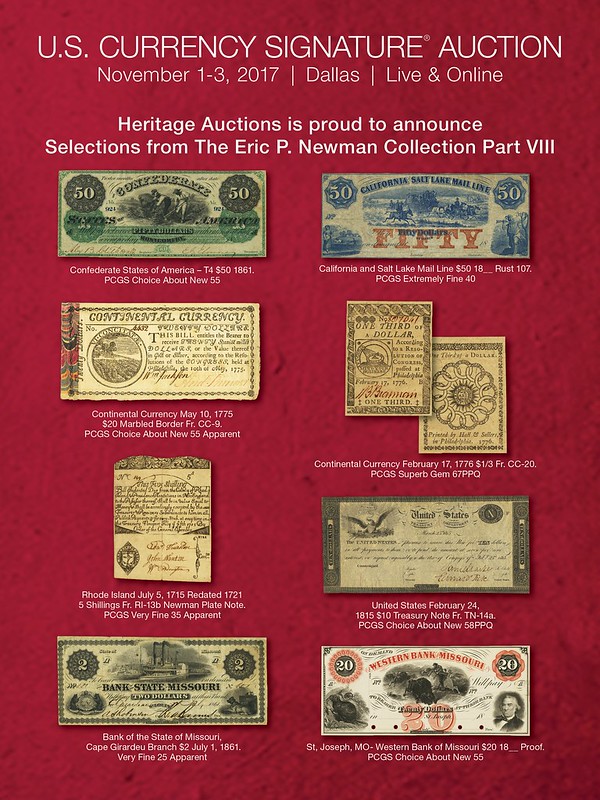
FELIX DELOS
 He was the owner of an 1804 silver dollar. After bargaining for two years he finally purchased it for only $100.00 in December 1897 from old time dealer, Hugh Roden, who owned since 1870 his shop selling books, curios, and coins at 408 Canal Street, New York.
He was the owner of an 1804 silver dollar. After bargaining for two years he finally purchased it for only $100.00 in December 1897 from old time dealer, Hugh Roden, who owned since 1870 his shop selling books, curios, and coins at 408 Canal Street, New York.
DELOS, FELIX
(https://sites.google.com/a/numismaticmall.com/www/numismaticmall-com/delos-felix)

MORE ON MAUNOVRY'S LESHER DOLLAR HOARD

NEW BOOK: FORGOTTEN COLORADO SILVER
(http://www.coinbooks.org/v20/esylum_v20n25a03.html)
JEAN FABIEN MAUNOVRY (1878-1942)
(http://www.coinbooks.org/v20/esylum_v20n40a21.html)
THE BOOK BAZARRE
HARVEY STACK'S NUMISMATIC FAMILY, PART 2
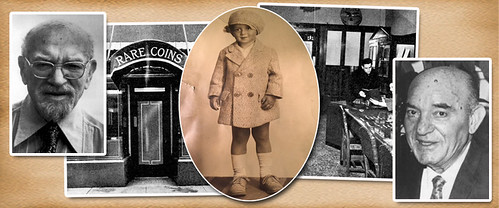
Growing up in a Numismatic Family Part 2
(http://www.stacksbowers.com/News/Pages/Blogs.aspx?ArticleID=2702)
HARVEY STACK'S NUMISMATIC FAMILY, PART 1
(http://www.coinbooks.org/v20/esylum_v20n39a14.html)
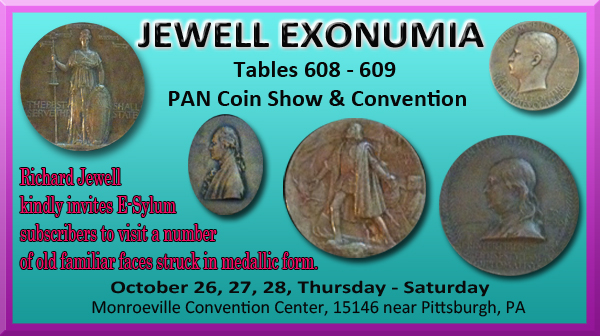
NOTES ON THE ORIGINS OF THE CONTINENTAL DOLLAR

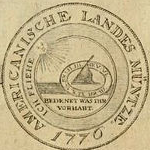
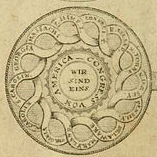
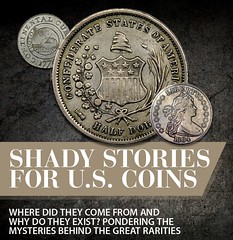 My article was about four coins: 1804 dollar and Confederate half (made by governments, but as souvenirs and not issued as money), Confederate cent and Continental Currency coins (no evidence linking them to any government). With respect to the Continental Currency coins, I reiterate Eric’s evidence and discuss how it is all indirect and therefore weak. I also discuss the evidence against them being intended as a circulating coinage. I call Eric’s discovery of the 1783 publication “if not a true smoking gun, then at least a flintlock with a suspiciously warm barrel” telling us when they were made.
My article was about four coins: 1804 dollar and Confederate half (made by governments, but as souvenirs and not issued as money), Confederate cent and Continental Currency coins (no evidence linking them to any government). With respect to the Continental Currency coins, I reiterate Eric’s evidence and discuss how it is all indirect and therefore weak. I also discuss the evidence against them being intended as a circulating coinage. I call Eric’s discovery of the 1783 publication “if not a true smoking gun, then at least a flintlock with a suspiciously warm barrel” telling us when they were made.
For more background I reached out to author Joel Orosz, who adds these observations.
-Editor
"Surely if such records exist someone would have located them by now" - NOT! It took until 2014 for the German illustration to come to light in the numismatic world, and 29 years from the publication in Joel's book of that important nugget preserved by Du Simitiere to be picked up on by Bill Nyberg.
There may well be other evidence that just hasn't been found or publicized yet.
But until something does come to light, we can't let our speculation run amok. We'll have to stick with the facts as we know them today.
-Editor
ON THE ORIGINS OF THE CONTINENTAL DOLLAR
(http://www.coinbooks.org/v20/esylum_v20n40a13.html)
NEW BOOK: TRUTH SEEKER: THE LIFE OF ERIC P. NEWMAN
(http://www.coinbooks.org/esylum_v19n03a04.html)

SELECTIONS FROM NEWMAN VIII: TALE OF TWO TENS
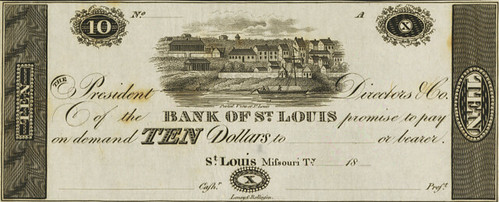
St. Louis, Missouri Ty. - Bank of St. Louis (1st) $10 18__...
(https://currency.ha.com/itm/obsolete-banknotes/st-%20louis-%20missouri-ty-%20bank-of-%20st-louis-%201st-10-%2018-mo-%2045-g26-%20proof-%20pcgs-choice-%20about-new-%2058-apparent/p/3547-%2011232.s?ic4=GalleryView-ShortDescription-%20071515)
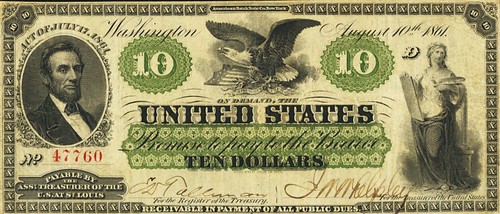
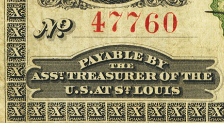 Despite the specie suspension, Demand
Notes were still receivable for United States fees and
duties, acting as gold, and were retired by the Government
when so applied. These redemptions made all Demand
Notes rare by the end of the war. The condition is a
mesmerizing PCGS Very Fine 30, making the Newman
example a most impressive survivor. It boasts a fascinating
pedigree with the note obtained in 1939 from Obsolete
currency scholar and dealer D. C. Wismer for $125.00.
Despite the specie suspension, Demand
Notes were still receivable for United States fees and
duties, acting as gold, and were retired by the Government
when so applied. These redemptions made all Demand
Notes rare by the end of the war. The condition is a
mesmerizing PCGS Very Fine 30, making the Newman
example a most impressive survivor. It boasts a fascinating
pedigree with the note obtained in 1939 from Obsolete
currency scholar and dealer D. C. Wismer for $125.00.
United States of America - Fr. 10 $10 1861 St. Louis Deman...
(https://currency.ha.com/itm/demand-notes/united-%20states-of-%20america-fr-%2010-10-%201861-st-%20louis-demand-%20note-pcgs-%20very-%20fine-30/p/3547-%2011417.s?ic3=ViewItem-Auction-%20Preview-%20SearchResults-120115&lotPosition=0|0)

TRAVEL QUIZ: QUART AND LI
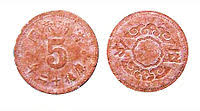
Manchukuo 5-fen fibre coin (= 50 li)
TRAVEL QUIZ REVIEW
(http://www.coinbooks.org/v20/esylum_v20n40a24.html)
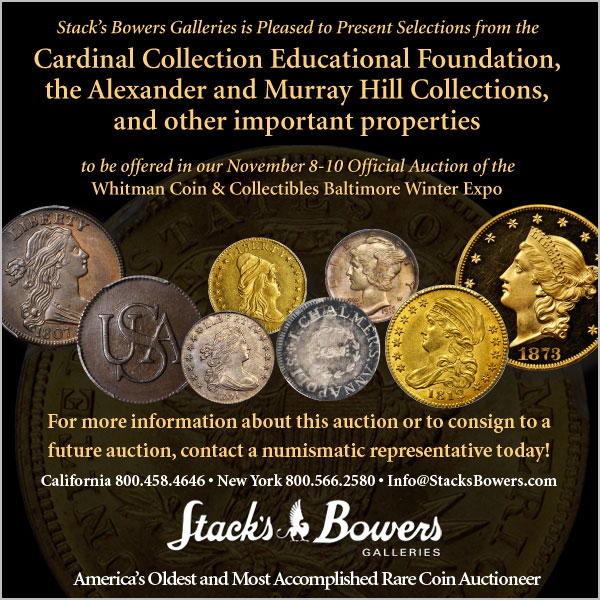
NUMISMATIC NUGGETS: OCTOBER 8, 2017
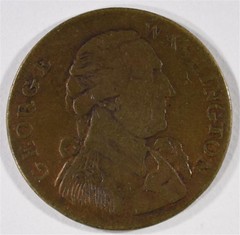

Lot 379: BEAUTIFUL WASHINGTON TOKEN
(https://www.invaluable.com/auction-lot/-1-c-872440DAAF)
NNP Library //Library Search // 37 records found.
(https://nnp.wustl.edu/library/advancedsearch?
contenttype=Periodical&title=&author=&publisher=
&searchlow=&searchhigh=&fullsearchterm=washington+success+token)
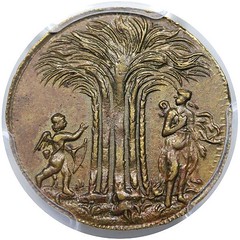
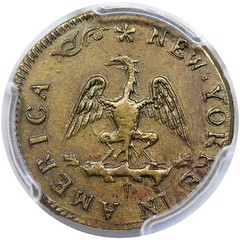
NEW YORKE TOKEN BRASS *** PCGS AU55
(http://www.hlrc.com/Inventory/CoinViewer?id=867666001&c=22)
The New Yorke in America Token, between 1668 and 1673: Introduction
(https://coins.nd.edu/ColCoin/ColCoinIntros/NewYorke.intro.html)

Condition Census 1795 Cohen-2a Half Cent to be Featured in our November 2017 Baltimore Auction
(http://www.stacksbowers.com/News/Pages/Blogs.aspx?ArticleID=2704)
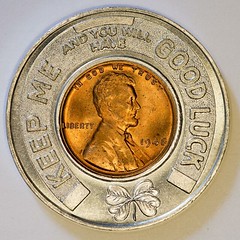
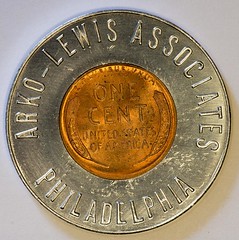
Lot 51: Arko-Lewis Associates Philadelphia PA Keep Me & Never Go Broke / Good Luck Token Encased 1948 Wheat Cent
(https://www.invaluable.com/auction-lot/-1-c-624485E9BD)
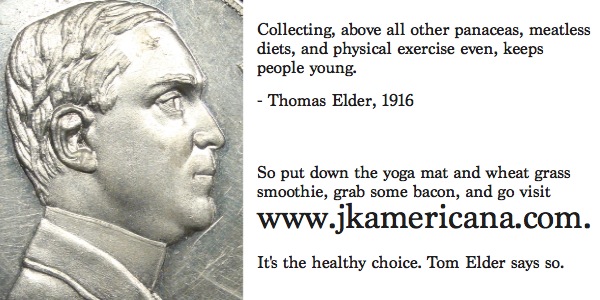
HARRY'S MEDAL SELECTIONS: OCTOBER 8, 2017
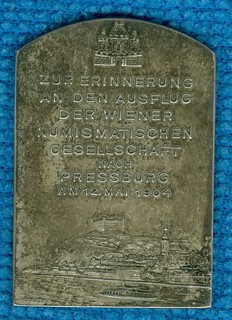
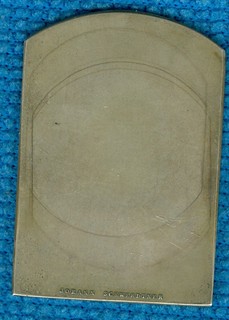
1904 Austrian Silver Medal Issued for the Vienna Numismatic Tour of Pressburg
(http://www.ebay.com/itm/1904-Austrian-Silver-Medal-Issued-for-the-Vienna-Numismatic-Tour-of-Pressburg-/112584005875)
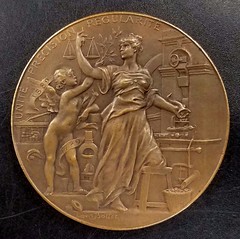
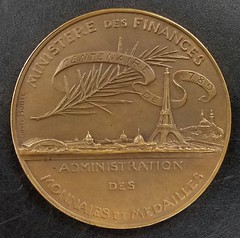
1889 Minister of Finance, Moneys & Medals, Centennial, France, bronze medal!
(http://www.ebay.com/itm/1889-Minister-of-Finance-Moneys-Medals-Centennial-France-bronze-medal-/263236443700)
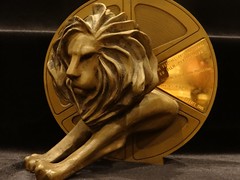
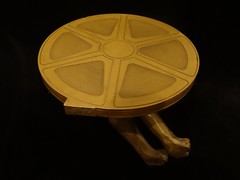
French Cannes Film Festival Advertising Award Trophy 1989 Steve Horn Productions
(http://www.ebay.com/itm/French-Cannes-Film-Festival-Advertising-Award-Trophy-1989-Steve-Horn-Productions-/152696815132)

DECIMUS ALBINUS: THE “OTHER BRUTUS”
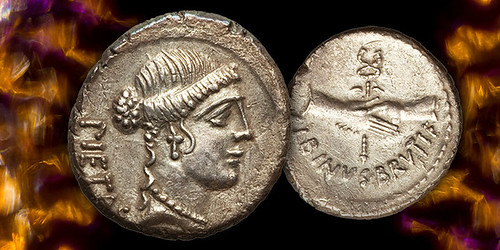
Ancient Coin Profile – Decimus Albinus: The “Other Brutus” Who Stabbed Caesar
(https://coinweek.com/ancient-coins/ancient-coin-profile-decimus-albinus-brutus-stabbed-caesar/)

SOUTH BOHEMIA SILVER COIN HOARD DISPLAYED
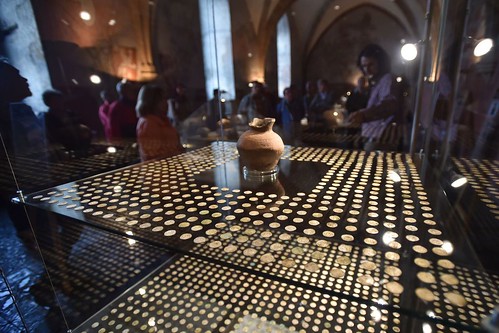
RARE COIN TREASURE TROVES HEADED FOR CZECH MUSEUM
(http://www.radio.cz/en/section/curraffrs/rare-coin-treasure-troves-headed-for-czech-museum)
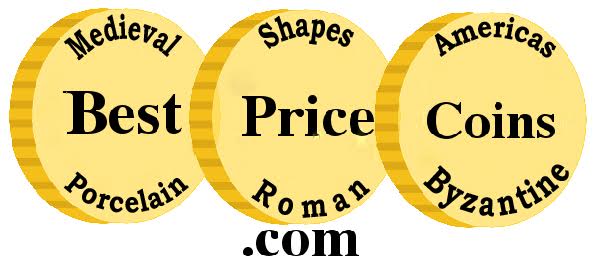
NEW COINS FOR QUEEN'S WEDDING ANNIVERSARY
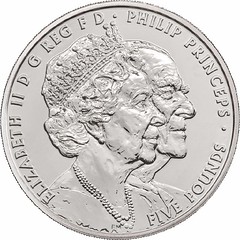

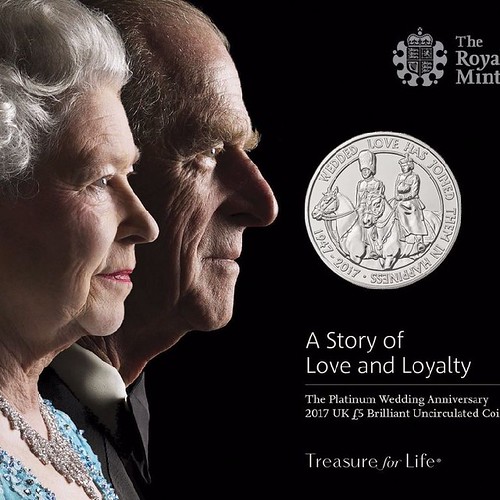
New coins created to mark the Queen's wedding anniversary
(https://stv.tv/news/uk/1398961-new-platinum-coins-created-to-mark-queen-and-prince-philip-s-70th-wedding-a/)

REPORTER TOURS DE LA RUE BANKNOTE PLANT
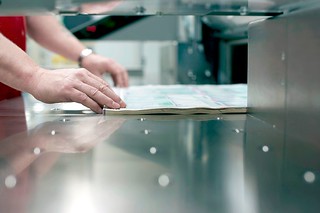 Journal business editor Graeme Whitfield is given a rare look inside the De La Rue factory in Gateshead to see currency from around the world being printed.
Journal business editor Graeme Whitfield is given a rare look inside the De La Rue factory in Gateshead to see currency from around the world being printed.
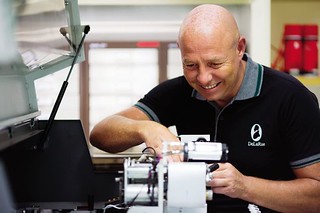 But it is also very much worth it. There is something uniquely fascinating, after all, about seeing hundreds of bank notes whizzing off a printer, being cut into single units, checked and boxed up to be flown around the world.
But it is also very much worth it. There is something uniquely fascinating, after all, about seeing hundreds of bank notes whizzing off a printer, being cut into single units, checked and boxed up to be flown around the world.
Take a look inside the Gateshead factory where 50 million banknotes are produced each week
(http://www.chroniclelive.co.uk/business/business-news/take-look-inside-gateshead-factory-13697061)

1928 D. H. LAWRENCE CHEQUE OFFERED
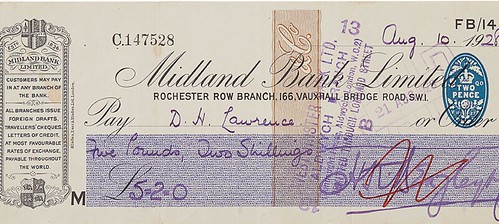
Lyon & Turnbull to sell a cheque paid to D.H Lawrence for the purchase of his banned book, Lady Chatterly's Lover
(http://artdaily.com/news/99335/Lyon---Turnbull-to-sell-a-cheque-paid-to-D-H-Lawrence-for-the-purchase-of-his-banned-book--Lady-Chatterly-s-Lover#.Wdi9OGhSyAs)

